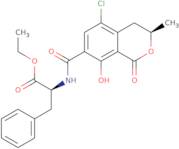Ochratoxin C
CAS: 4865-85-4
Ref. 3D-FO26491
| 1mg | Discontinued | ||
| 2mg | Discontinued | ||
| 5mg | Discontinued | ||
| 500µg | Discontinued | ||
| 1000µg | Discontinued | ||
| 2000µg | Discontinued | ||
| 5000µg | Discontinued | ||
| 10000µg | Discontinued |
Product Information
- N-[[(3R)-5-Chloro-3,4-dihydro-8-hydroxy-3-methyl-1-oxo-1H-2-benzopyran-7-yl]carbonyl]-L-phenylalanine ethyl esterN-[(5-Chloro-8-hyd roxy-3-methyl-1-oxo-7-isochromanyl)carbonyl]-3-phenyl-L-alanine ethyl esterOchratoxin A ethyl ester
- (R)-N-[(5-Chloro-3,4-dihy dro-8-hydroxy-3-methyl-1-oxo-1H-2-benzopyran-7-yl)car bonyl]-L-phenyl alanine ethyl ester
- 4865-85-4
- <span class="text-smallcaps">L</span>-Phenylalanine, N-[(5-chloro-3,4-dihydro-8-hydroxy-3-methyl-1-oxo-1H-2-benzopyran-7-yl)carbonyl]-, ethyl ester, (R)-
- <span class="text-smallcaps">L</span>-Phenylalanine, N-[[(3R)-5-chloro-3,4-dihydro-8-hydroxy-3-methyl-1-oxo-1H-2-benzopyran-7-yl]carbonyl]-, ethyl ester
- Alanine, N-[(5-chloro-8-hydroxy-3-methyl-1-oxo-7-isochromanyl)carbonyl]-3-phenyl-, ethyl ester, <span class="text-smallcaps">L</span>-
- L-phenylalanine, N-[[(3R)-5-chloro-3,4-dihydro-8-hydroxy-3-methyl-1-oxo-1H-2-benzopyran-7-yl]carbonyl]-, ethyl ester
- Ochratoxin A ethyl ester
- Alanine, N-[(5-chloro-8-hydroxy-3-methyl-1-oxo-7-isochromanyl)carbonyl]-3-phenyl-, ethyl ester, L-
- L-Phenylalanine, N-[(5-chloro-3,4-dihydro-8-hydroxy-3-methyl-1-oxo-1H-2-benzopyran-7-yl)carbonyl]-, ethyl ester, (R)-
- See more synonyms
Ochratoxin C is a mycotoxin that has been shown to be cytotoxic at high concentrations. It has been detected in human serum, cell culture, and hydrogen bond. The detection sensitivity of Ochratoxin C is low due to its lack of fluorescence. Ochratoxin C binds to the hydroxyl group on proteins and can be detected using magnetic particles and monoclonal antibodies. Ochratoxin C has been detected in patients with chronic renal failure and in animals with liver cirrhosis. This toxin inhibits protein synthesis by blocking the ribosome-binding site on the mRNA molecule. It also induces DNA damage by forming adducts with DNA bases or crosslinks with DNA strands.





